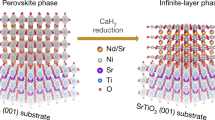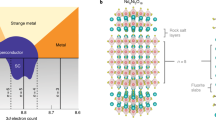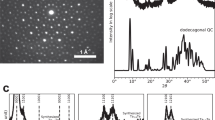Abstract
The electronic properties of crystals with a layered structure can be radically altered by the intercalation, between the layers, of guest species that act as electron donors or acceptors. Such studies have been performed extensively on graphite, transition-metal dichalcogenides and oxide bronzes1. Interest in redox intercalation reactions2 has increased recently because the high-transition-temperature (high-Tc) superconductors based on copper oxide also have layered structures, the superconductivity occurring within two-dimensional CuO2 planes separated by charge-reservoir oxide layers3. Similarly, in metal-doped fullerenes, which show relatively high transition temperatures, the electron donor atoms sit in the interstitial sites between adjacent fullerene balls4. In a previous study5, we described a layered nitride, β-ZrNCl, consisting of Zr–N double layers sandwiched between two close-packed chlorine layers. On lithium intercalation, the crystal changed from a semiconductor to a metal, and became a superconductor at 13 K. Here we report the properties of the isostructural compound β-HfNCl. After electron-doping the crystal by lithium intercalation, we observe superconductivity with a Tc of up to 25.5 K. This transition temperature is higher than that observed in any intermetallic compound, and suggests that layered nitride structures may offer transition temperatures comparable to those observed in layered copper oxide structures.
This is a preview of subscription content, access via your institution
Access options
Subscribe to this journal
Receive 51 print issues and online access
$199.00 per year
only $3.90 per issue
Buy this article
- Purchase on Springer Link
- Instant access to full article PDF
Prices may be subject to local taxes which are calculated during checkout




Similar content being viewed by others
References
Whitingham, M. S. & Jacobson, A. J. (eds) Intercalation Chemistry(Academic, New York, (1982).
Dresselhaus, M. S. New directions in intercalation research. Mol. Cryst. Liq. Cryst. 244, 1–12 (1994).
Cava, R. J. Structural chemistry and the local charge picture of copper oxide superconductors. Science 247, 656–662 (1990).
Tanigaki, K. Development of superconductors based on C60. Springer Proc. Phys. 81, 172–185 (1996).
Yamanaka, S., Kawaji, H., Hotehama, K. & Ohashi, M. Anew layer-structured nitride superconductor. Lithium-intercalated β-zirconium nitride chloride, LixZrNCl. Adv. Mater. 9, 771–774 (1996).
Ohashi, M., Yamanaka, S., Sumihara, M. & Hattori, M. Novel synthesis of the layer structured β-ZrNCl by the direct reaction of zirconium metal or zirconium hydride with ammonium chloride. J.Solid State Chem. 75, 99–104 (1988).
Ohashi, M., Yamanaka, S. & Hattori, M. Chemical vapor transport of layer structured crystal β-ZrNCl. J. Solid State Chem. 77, 342–347 (1988).
Juza, R. & Heners, J. Über Nitridhalogenide des Titans and Zircons. Z. Anorg. Allg. Chem. 332, 159–172 (1964).
Juza, R. & Friedrichsen, H. Die Kristallstruktur von β-ZrNCl und β-ZrNBr. Z. Anorg. Allg. Chem. 332, 173–178 (1964).
Henn, R. W., Schnelle, W., Kremer, R. K. & Simon, A. Bulk superconductivity at 10 K in the layered compounds Y2C2I2and Y2C2Br2. Phys. Rev. Lett. 77, 374–377 (1996).
Ohashi, M., Yamanaka, S. & Hattori, M. Preparation and electrical conductivities of layer structured crystals ZrNX (X=Br, I). J. Ceram. Soc. Jpn Int. Edn 97, 1175–1181 (1989).
Kawaji, H., Hotehama, K. & Yamanaka, S. Superconductivity of alkali metal intercalated β-zirconium nitride chloride AxZrNCl (A=Li, Na, K). Chem. Mater. 9, 2127–2130 (1997).
Zandbergen, H. W., Jansen, J., Cava, R. J., Krajewski, J. J. & Peck, W. F. J Structure of the 13-K superconductor La3Ni2B2N3and the related phase LaNiBN. Nature 372, 759–761 (1994).
Schöllhorn, R. in Intercalation Chemistry(eds Whittingham, M. S. & Jacobson, A. J.) 315–360 (Academic, New York, (1982).
Johnston, D. C. Observation of new cointercalation compounds in the system Na0.33(H2O)yTaS2(0≤y≤2) from powder X-ray diffraction measurements. J. Less-Common Met. 84, 327–347 (1982).
Ohashi, M., Uyeoka, K., Yamanaka, S. & Hattori, M. Co-intercalation of terahydrofuran and propylene carbonate with alkali metals in β-ZrNCl layer structured crystal. Bull. Chem. Soc. Jpn 64, 2814–2818 (1991).
Roberts, B. W. Survey of superconductive materials and critical evaluation of selected properties. J. Phys. Chem. Ref. Data 5, 581–795 (1976).
Pessall, N. & Hulm, J. K. Superconducting alloys of interstitial compounds. Physics 2, 311–328 (1966).
Acknowledgements
This study was partially supported by the Grant-in-Aid from the Japan Ministry of Education for Science, Culture and Sports.
Author information
Authors and Affiliations
Corresponding author
Rights and permissions
About this article
Cite this article
Yamanaka, S., Hotehama, Ki. & Kawaji, H. Superconductivity at 25.5 K in electron-doped layered hafnium nitride. Nature 392, 580–582 (1998). https://doi.org/10.1038/33362
Received:
Accepted:
Issue Date:
DOI: https://doi.org/10.1038/33362
This article is cited by
-
An analysis of structural phase transition and allied properties of cubic ReN and MoN compounds
Journal of Molecular Modeling (2021)
-
Methods of Producing Ceramic on the Basis of Metal Nitrides (Review)
Glass and Ceramics (2019)
-
Synthesis and Superconductivity of Electron-Doped β-ZrNCl with Partial Substitution of Ti on Zr Site
Journal of Superconductivity and Novel Magnetism (2018)
-
Single-crystal-to-single-crystal intercalation of a low-bandgap superatomic crystal
Nature Chemistry (2017)
-
Synthesis and Superconductivity of Layered Compounds with Orthogonal [Zr2N2] Network
Journal of Superconductivity and Novel Magnetism (2017)
Comments
By submitting a comment you agree to abide by our Terms and Community Guidelines. If you find something abusive or that does not comply with our terms or guidelines please flag it as inappropriate.



